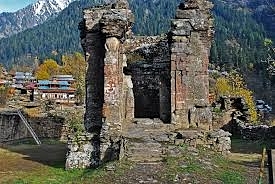
A Look At Kashmir's Literary Heritage
What is intriguing about Kashmir is that its lesser known peaks are filled with far greater beauty than the more well-known ones
नमस्ते शारदादेवि काश्मिरपुरवासिनि। त्वामहं प्रार्थये नित्यं विद्यां बुद्धिञ्च देहि मे।।
A familiar prayer that has intrigued me for years. In Karnataka one associates the beautiful, placid town of Sringeri with Sharada. Now how is Kashmir associated with the deity of Shankaracharya’s Sringeri?
There are well-known stories of Shankaracharya ascending the ‘Sarvajna Peetha’ in Kashmir. Then there is the story of the poet Sriharsha visiting Sharada Peetha and presenting his epic ‘Naishadha Charitam’ there. Kashmir and scholarship seem intertwined.
The Internet provides materials about ‘Sharda Peeth’ just across the Line of Control in Kashmir with a few photographs of the ruins of a temple on the banks of the river Madhumati (Neelum). This place is about 80 kilometres from Baramulla, which was called Varahamula (वराहमूल), and also has reference to the incarnation of Vishnu and also to the origin of the valley.
Legend has it that Kashyapa drained an extraordinarily large lake to create the present valley of Kashmir.
I put forward a hypothesis for how the name ‘Kashmir’ may have been formed from this story. In Sanskrit, ‘kam’ (कम्) means water and ‘shmeela’ (श्मील निमेषणे) means to wink or close one’s eyes.
Transposition of ‘L’ and ‘R’ is quite common (रलयोरभेदः), potentially leading to the name ‘Kashmir’ – “land created by the draining or closing of water”. Guess all that ‘natural’ beauty of the place owes much to the genius of a human.
The story and the hypothesis aside, it is evident that scholars and sages from various parts of the country deemed it extremely important to visit the Sharada Peeth and Kashmir.
What drove such reverence? Who were those brilliant scholars, poets and philosophers whose eminence attracted such veneration? The objective of this series is to pique the reader’s interest about this great part of the country by providing an overview of some of those geniuses who roamed the beautiful land of Kashmir. These visitors made Kashmir and India richer by their literary contribution.
Hypotheses and legends place a large number of great poets from Kalidasa to Ashwaghosha in Kashmir, but these legends and hypotheses are disputed.
As there is immense confusion about history and dates about most Indian poets, a great starting point is always the most undisputed territory. One of those rare Indian poets whose history is undisputed is the historian Kalhana of the 12th century Kashmir.
Kalhana was the son of Champaka, the Prime Minister of Kashmir, which he relates in his work. His work, Rajatarangini is a celebrated historical account of Kashmir. In one of the first shlokas of this work, he expounds that only an agnostic historian, free from bias should be praised.
श्लाघ्यः स एव गुणवान् रागद्वेषबहिष्कृता। भूतार्थकथने यस्य स्थेयस्येव सरस्वती।। 7।।
Kalhana demonstrates this when he criticizes several rulers for their inability to discriminate between fools and scholars or for their cruel punishments meted out to citizens.
Kalhana catalogues several historians who came before him like Suvrata, Kshemendra, Neelamuni, Helaraja and Padmamihara.
He points to the errors in their historical accounts which he claims to have corrected, by means of reviewing various records including edicts and grant of titles to land.
Clearly, recording history and use of evidence to verify the story-telling, is indigenous to India, though several modern historians would have one believe otherwise.
Kalhana talks about the creation of Kashmir by Kashyapa, as was described earlier, by plugging the water-source of a large lake.
कश्यपेन तदन्तःस्थं घातयित्वा जलोद्भवम्। निर्ममे तत्सरोभूमौ कश्मीरा इति मण्डलम् ।। 27।।
He speaks fondly of Sharada and her abode in Kashmir, on the banks of Madhumati, in verse 37. His work is treasure house of information on cultures, places and legends of Kashmir from Srinagar to Sheshnag.
An example is the detailed story leading to the creation of the Sheshnag Lake, which he says can be seen by travelers on their way to worship Amareshwara (Amarnath).
One cannot but be mesmerized by the recurring motifs of Nagas in India from the feet of Amareshwara in Kashmir to the feet of Ananta Padmanabha in Kerala. Kalhana is very cognizant of the expanse of India and its people and brings it up in multiple places while talking of kingdoms, culture and poets.
Kalhana’s use of qualifiers like ‘perhaps’ (प्रायः) in several places is quite striking. Kalhana pays great attention to institution-building from the times of Jaloka to his contemporary kings.
Clearly, governance and statecraft was an important part of the discourse in India at all times as evidenced by the various Parvas of Mahabharata to the Arthashastra to the Panchatantra to the Rajatarangini.
One wonders why eminent historians of the present day don’t prescribe such a brilliant work as a mandatory reading material for budding historians. Thanks to Javaji’s ‘Nirnaya Sagara Press’, this fantastic historical treatise is available to readers.
Nirnaya Sagara Press has also published Kalhana’s ‘Ardhanarishwara Stotram’ (अर्धनारीश्वरस्तोत्रम्), which has a delightful set of alliterative verses filled with the imagery of Ardhanarishwara.
Through Kalhana one sees a glimpse of the eclectic works of the scholars who called Kashmir home. Kashmir is like the Himalayas themselves where some of the lesser known peaks are filled with far greater beauty than the more well-known ones from other parts. So, the next sojourn will be to those lesser known peaks before attempting the journeys to the well-known peaks.